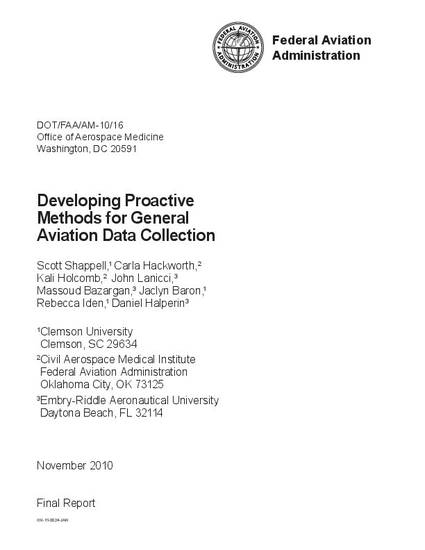
Book
Developing Proactive Methods for General Aviation Data Collection
(2010)
Abstract
Introduction. Over the last 20 years, nearly 40,000 general aviation (GA) aircraft were involved in accidents,
roughly 20% of which were fatal. To address this safety concern, scientists have often relied on accident data.
Because of the rare nature of accidents, commercial aviation incident and near miss data may prove to be useful
sources of safety information. In one such study, the National Transportation Safety Board interviewed GA
pilots that were flying near a weather-related accident in pursuit of a different perspective than that of the
accident pilot. Interviewing GA pilots about their own weather-related event may provide similar benefits.
Method. To understand factors leading GA pilots to encounter adverse weather conditions, pilots involved in an
adverse weather encounter were interviewed using a one-hour structured interview. The interview was developed
using surveys utilized by National Aeronautics and Space Administration and the Federal Aviation
Administration (FAA). In total, 27 pilots who experienced an adverse weather encounter were interviewed, of
which 25 were included in the final analysis.
Results. Previous studies conducted by the FAA and others found many GA accidents involving flight into
adverse weather were categorized as a willful disregard for the rules and regulations of safety; violations as defined by the Human Factors Analysis and Classification System. Contrary to what the accident record seems to
suggest, flight into adverse weather may also be influenced by the lack of appreciation/understanding of the
hazards associated with adverse weather. Perhaps some encounters with adverse weather were motivated by
outside influences or exacerbated by some manner of mechanical failure that may have led to the willful
acceptance of unnecessary hazards.
Conclusions. These data suggest that current beliefs surrounding flight into adverse weather by GA pilots may be incomplete. The data presented here suggest that additional effort should be placed in training, both ab initio
and recurrent. Emphasis should be placed on ensuring a full understanding of the adverse impact of weather,
including the recognition of instrument meteorological conditions, icing, convective events, etc. Likewise, with
the proliferation of commercial weather products and on-board weather equipment, it may be time to move
toward some form of standard weather package that all pilots would review before flying.
Keywords
- general aviation,
- aviation weather encounters,
- weather knowledge,
- pilot education and training
Disciplines
Publication Date
November, 2010
Publisher
United States Federal Aviation Administration, Office of Aerospace Medicine
Series
DOT/FAA/AM-10/16
Citation Information
Scott Shappell, Carla Hackworth, Kali Holcomb, John Lanicci, et al.. Developing Proactive Methods for General Aviation Data Collection. Washington, DC(2010) Available at: http://works.bepress.com/scott-shappell/71/
